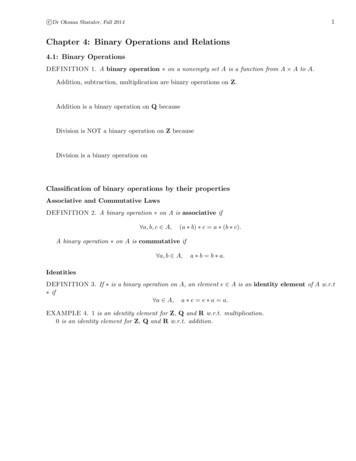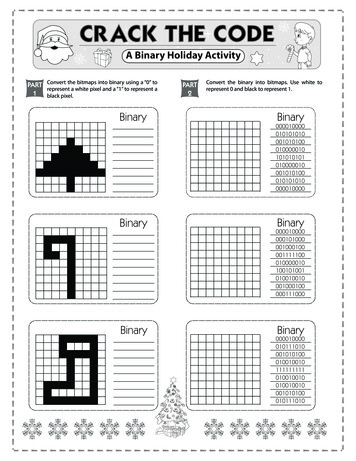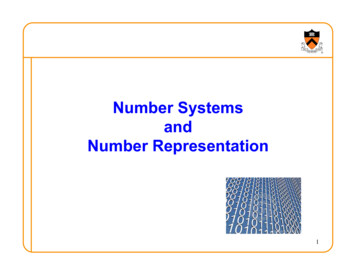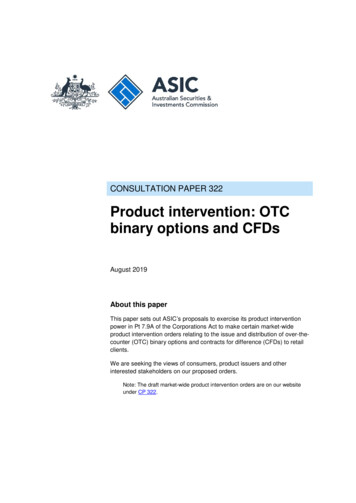
Transcription
c Dr Oksana Shatalov, Fall 20141Chapter 4: Binary Operations and Relations4.1: Binary OperationsDEFINITION 1. A binary operation on a nonempty set A is a function from A A to A.Addition, subtraction, multiplication are binary operations on Z.Addition is a binary operation on Q becauseDivision is NOT a binary operation on Z becauseDivision is a binary operation onClassification of binary operations by their propertiesAssociative and Commutative LawsDEFINITION 2. A binary operation on A is associative if a, b, c A,(a b) c a (b c).A binary operation on A is commutative if a, b A,a b b a.IdentitiesDEFINITION 3. If is a binary operation on A, an element e A is an identity element of A w.r.t if a A, a e e a a.EXAMPLE 4. 1 is an identity element for Z, Q and R w.r.t. multiplication.0 is an identity element for Z, Q and R w.r.t. addition.
c Dr Oksana Shatalov, Fall 20142InversesDEFINITION 5. Let be a binary operation on A with identity e, and let a A. We say that a isinvertible w.r.t. if there exists b A such thata b b a e.If f exists, we say that b is an inverse of a w.r.t. and write b a 1 .Note, inverses may or may not exist.EXAMPLE 6. Every x Z has inverse w.r.t. addition because x Z,x ( x) ( x) x 0.However, very few elements in Z have multiplicative inverses. Namely,EXAMPLE 7. Let be a binary operation on Z defined by a, b Z,a b a 3b 1.(a) Prove that the operation is binary.(b) Determine whether the operation is associative and/or commutative. Prove your answers.(c) Determine whether the operation has identities.(d) Discuss inverses.
c Dr Oksana Shatalov, Fall 20143EXAMPLE 8. Let be a binary operation on the power set P (A) defined by X, Y P (A),X Y X Y.(a) Prove that the operation is binary.(b) Determine whether the operation is associative and/or commutative. Prove your answers.(c) Determine whether the operation has identities.(d) Discuss inverses.EXAMPLE 9. Let be a binary operation on F (A) defined by f, g F (A),f g f g.(a) Prove that the operation is binary.(b) Determine whether the operation is associative and/or commutative. Prove your answers.
c Dr Oksana Shatalov, Fall 20144(c) Determine whether the operation has identities.(d) Discuss inverses.EXAMPLE 10.1Let be a binary operation on the set M2 (R) of all 2 2 matrices defined by A1 , A2 M2 (R),A1 A2 A1 A2 .(a) Prove that the operation is binary.(b) Determine whether the operation is associative and/or commutative. Prove your answers.1se Appendix at the end of the Chapter.
c Dr Oksana Shatalov, Fall 20145(c) Determine whether the operation has identities.(d) Discuss inverses.EXAMPLE 11. Let be a binary operation on the set M2 (R) of all 2 2 matrices defined by A1 , A2 M2 (R),A1 A2 A1 A2 .(a) Prove that the operation is binary.(b) Determine whether the operation is associative and/or commutative. Prove your answers.
c Dr Oksana Shatalov, Fall 20146 (c) Show that the matrix I 1 00 1 is an identity element w.r.t. .(d) Discuss inverses (Use the following FACT: “A matrix is invertible if and only if its derminant doesnot equal to zero”).PROPOSITION 12. Let be a binary operation on a nonempty set A. If e is an identity element onA then e is unique.Proof.PROPOSITION 13. Let be an associative binary operation on a nonempty set A with the identity e,and if a A has an inverse element w.r.t. , then this inverse element is unique.Proof. See Exercise 12.
c Dr Oksana Shatalov, Fall 20147ClosureDEFINITION 14. Let be a binary operation on a nonempty set A, and suppose that X A. If isalso a binary operation on X then we say that X is closed in A under .EXAMPLE 15. Determine whether the following subsets of Z are closed in Z under addition and multiplication.(a) Z (b) E(c) OEXAMPLE 16. Determine whether the following subsets of M2 (R) is closed in M2 (R) under matrixaddition and multiplication: a b M2 (R) a d.S c d
c Dr Oksana Shatalov, Fall 201484.2: Equivalence RelationsDEFINITION 17. A relation R on a set A is a subset of A A. If (a, b) R, we write aRb.EXAMPLE 18. On the set R one can define aRb by a b. Then, for example,EXAMPLE 19. On the power set P (Z) one can define R by ARB if A B .Properties of RelationsDEFINITION 20. Let R be a relation on a set A. We say:1. R is reflexive if aRa, a A.2. R is symmetric if a, b A, if aRb then bRa.3. R is transitive if a, b, c A, if aRb and bRc, then aRc.4. R is antisymmetric if a, b A, if aRb and bRa, ten a b.DEFINITION 21. A relation R on a set A is called an equivalence relation if it is reflexive, symmetric, and transitive.EXAMPLE 22. Let R be the relation on Z defined by aRb if a b. Determine whether it is reflexive,symmetric, transitive, or antisymmetric.
c Dr Oksana Shatalov, Fall 20149EXAMPLE 23. Let R be the relation on R defined by aRb if a b 1 (that is a is related to b ifthe distance between a and b is at most 1.) Determine whether it is reflexive, symmetric, transitive, orantisymmetric.EXAMPLE 24. Let R be the relation on Z defined by aRb if a 3b E. Show that R is an equivalencerelation.REMARK 25. When R is an equivalence relation, it is common to write a b instead of aRb, read “ais equivalent to b.”
c Dr Oksana Shatalov, Fall 201410EXAMPLE 26. Let n Z . Define aRb on Z by n a b. (In particular, if n 2 the aRb means a bis). Show that R is an equivalence relation.REMARK 27. The above relation is called congruence mod n, and usually writtena b (mod n)
c Dr Oksana Shatalov, Fall 201411Equivalence ClassesDEFINITION 28. If R is an equivalence relation on a set A, and a A, then the set[a] {x A x a}is called the equivalence class of a. Elements of the same class are said to be equivalent.EXAMPLE 29. Define aRb on Z by 2 a b. (In other words, R is the relation of congruencemod 2 on Z.)(a) What integers are in the equivalence class of 6?(b) What integers are in the equivalence class of 25?(c) How many distinct equivalence classes there? What are they?EXAMPLE 30. Define aRb on Z by n a b. (In other words, R is the relation of congruence mod n onZ.)(a) How many distinct equivalence classes there? What are they?
c Dr Oksana Shatalov, Fall 201412(b) Show that the set of these equivalence classes forms a partition of Z.THEOREM 31. If R is an equivalence relation on a nonempty set A, then the set of equivalence classeson R forms a partition on A.Proof.So, any equivalence relation on a set A leads to a partition of A. In addition, any partition of A givesrise to an equivalence relation on A.
c Dr Oksana Shatalov, Fall 201413THEOREM 32. Let R be a partition of a nonempty set A. Define a relation R1 on A by aR1 b if a andb are in the same element of the partition R. Then R1 is an equivalence relation on A.Proof.Conclusion: Theorems 31 and 32 imply that there is a bijection between the set of all equivalencerelations of A and the set of all partitions on A.EXAMPLE 33. Let R be the relation on Z defined by aRb if a 3b E. By one of the above examples,R is an equivalence relation. Determine all equivalence classes for R.
c Dr Oksana Shatalov, Fall 201414Partial and linear orderingRecall that aRb defined by a b, a, b R, is not an equivalence relation. Why?DEFINITION 34. A relation R on a set A is called a partial ordering on A if R is reflexive, transitiveand antisymmetric.If A is a set and there exists a partial ordering on A, then we say that A is a partially ordered set.EXAMPLE 35. For all X, Y P (A) define R by X Y. Then R is a partial ordering of P (A).DEFINITION 36. Let A be a set and R be a partial ordering on A. We say that R is a linear orderingon A if for all a, b A either aRb, or bRa.EXAMPLE 37. is a linear ordering of REXAMPLE 38. Discuss when the relation from Example 35 is a linear ordering.
c Dr Oksana Shatalov, Fall 201415EXAMPLE 39. (cf. Example 17(c).) Let R be a relation on a set A. If R is both symmetric andantisymmetric, does it follow that R is reflexive?
c Dr Oksana Shatalov, Fall 201416Appendix: Matrices and Matrix Multiplication1. An m n (this is often called the size or dimension of the matrix) matrix is a table with m rowsand n columns and the entry in the i-th row and j-th column is denoted by aij : a11 a12 . . . a1n a21 a22 . . . a2n . . am1 am2 . . . amn2. A matrix is usually denoted by a capital letter and its elements by small letters : aij entry inthe ith row and jth column of A.3. Two matrices are said to be equal if they are the same size and each corresponding entry is equal.4. Special Matrices: A square matrix is any matrix whose size (or dimension) is n n (i.e. it has the same numberof rows as columns.) In a square matrix the diagonal that starts in the upper left and ends inthe lower right is often called the main diagonal. The zero matrix is a matrix all of whose entries are zeroes. The identity matrix is a square n n matrix, denoted In , whose main diagonal consists ofall 1’s and all the other elements are zero: 1 0 · · · 0 0 1 · · · 0 · · · · · · In · · · · · · · · · · · · 0 0 · · · 1 The diagonal matrix is a square n n matrix of the following form λ1 0 · · · 0 0 λ2 · · · 0 ·· · · · · · ····· ·· · · · · 0 0 · · · λn Column matrix ( column vector) and the row matrix ( row vector) are those matricesthat consist of a single column or a single row respectively: x1 x2 X . , Y y1 y2 . . . yn. . xnNote that an n-dimensional column vector is an n 1 matrix, and an n-dimensional row vectoris an 1 n matrix. Transpose of a Matrix: If A is an m n matrix with entries aij , then AT is the n mmatrix with entries aji .AT is obtained by interchanging rows and columns of A.
c Dr Oksana Shatalov, Fall 2014175. Matrix Arithmetic The sum or difference of two matrices of the same size is a new matrix of identical size whoseentries are the sum or difference of the corresponding entries from the original two matrices.Note that we cant add or subtract entries with different sizes. The scalar multiplication by a constant gives a new matrix whose entries have all beenmultiplied by that constant. If A, B, and C are matrices of the same size, then(a) A B B A (Commutative Law)(b) (A B) C A (B C) (Associative Law) Matrix multiplication: If Y is a row matrix of size 1 n and X is a column matrix of sizen 1 (see above), then the matrix product of Y and X is defined by x1 x2 Y X y1 y2 y3 · · · yn x3 y1 x1 y2 x2 y3 x3 · · · yn xn . . xn If A is an m p matrix and matrix B is p n, then the product AB is an m n matrix,and its element in the ith row and jth column is the product of the ith row of A and the jthcolumn of B. RULE for multiplying matrices:The column of the 1st matrix must be the same size as the row of the 2nd matrix.6. Example.(a) Given 124 ,A 3 1 2 1 24 B 312Compute A 2B.(b) Let A 1 2 3 0 1 and B 1 2 0 1 1 . Find BAT .
c Dr Oksana Shatalov, Fall 201418(c) Example. Given 124 ,A 3 1 2B 1 234Compute AB and BA when it is possible. 1 2 51 0 0(d) Compute 3 2 3 0 1 0 4 3 90 0 17. FACTS and LAWS FOR MATRIX MULTIPLICATION: If the size requirements are met for matrices A, B and C, then AB 6 BA (NOT always Commutative)2 A(B C) AB AC (always Distributive) (AB)C A(BC) (always Associative) AB 0 does not imply that A 0 or B 0. AB AC does not imply that B C. In A AIn A for any square matrix A of size n.Determinant8. Determinant of a matrix is a function that takes a square matrix and converts it into a number.9. Determinant of 2 2 matrix:a bc d ad bc10. Matrix Inverse. Let A be a square matrix of size n. A square matrix, A 1 , of size n, such thatAA 1 In (or , equivalently, A 1 A In ) is called an inverse matrix. a11 a12 111. A in the case n 2: If A thena21 a22 1a22 a12 1A detA a21 a1112. FACT: A 1 exists if and only if det A 6 0.2Since the multiplication of matrices is NOT commutative, you MUST multiply left to right.
If is a binary operation on A, an element e2Ais an identity element of Aw.r.t if 8a2A; ae ea a: EXAMPLE 4. 1 is an identity element for Z, Q and R w.r.t. multiplication. 0 is an identity element for Z, Q and R w.r.t. addition. c Dr Oksana Shatalov, Fall 2014 2 Inverses DEFINITION 5. Let be a binary operation on Awith identity e, and let a2A.











